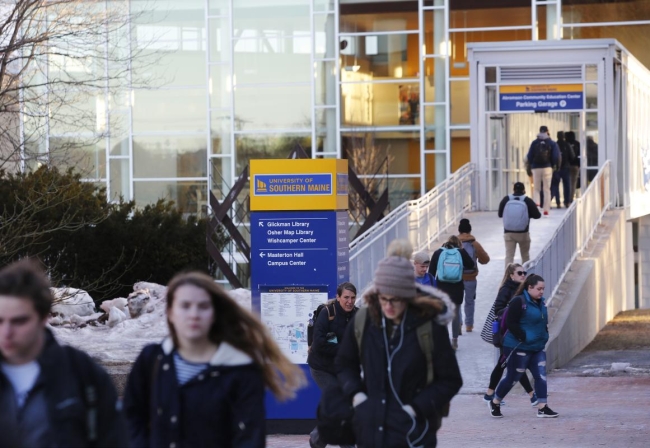You have /5 articles left.
Sign up for a free account or log in.

University of Southern Maine engineering faculty are among those raising concerns about the new college.
Derek Davis/Portland Press Herald via Getty Images
In 2020, the University of Maine system announced plans to establish a new Maine College of Engineering, Computing, and Information Science (MCECIS), funded by $75 million from the Harold Alfond Foundation and another $75 million in matched funds from the system.
It’s an ambitious project, part of a $240 million donation made by the Alfond Foundation in 2020 aimed at bringing “transformative change” to the system. The gift is the largest ever made to a public institution in New England and the eighth largest to any public institution in the U.S.
The MCECIS will consolidate the resources of the system’s various engineering, computer science and information science programs under one statewide institution based at the University of Maine at Orono. The goal is to double the number of engineering graduates from the system in order to help produce enough qualified workers to meet Maine’s growing need.
The MCECIS is inching forward—the system is already searching for an academic dean for the college. But it also faces significant challenges, chief among them establishing an organizational structure while assuaging concerns of faculty across the system about losing autonomy over their campus-specific programs.
Last month, Carlos Luck, chair of the University of Southern Maine’s electrical engineering department, told the system’s Board of Regents that he and other members of his department were concerned about the initiative. He cited worries about curricular autonomy, confusion over the “troubling ambiguity” of the new college’s structure, and fears that the MCECIS would erase distinct characteristics of USM’s engineering program.
Penny Rheingans, director of the University of Maine’s school of computing and information sciences and a co-lead on the MCECIS initiative, said she understands the faculty’s concerns, especially as head of a program that would be brought into the MCECIS fold. But she’s hopeful that an agreeable solution will be reached.
“I think discomfort with creating this stems from a fear that everything will be homogenized,” she said. “That would be counterproductive … You have to respect the differences between computing and engineering and between the institutions in the system. That’s the only way this is going to work.”
Organizational Structure Up in the Air
Joseph Szakas, the interim president of the University of Maine at Augusta and Rheingans’s co-lead on the initiative, called MCECIS’s organizational framework “a work in progress.”
“Probably in about two more months we’ll have a clearer road map,” he said.
In the meantime, Szakas believes the latest memorandum of understanding on the MCECIS should address faculty concerns.
“The MOU laid the groundwork to allay the fears of USM faculty that they were going to be subsumed by the University of Maine,” Szakas said. “I think it’s clear that isn’t going to happen.”
Luck isn’t so confident. While he was glad to see assurances in the MOU that USM Engineering would confer its own degrees and be accredited independently, his ongoing concerns are tied to a specific stipulation in the MOU that makes the USM school of engineering a division of the MCECIS—which is itself a college of the University of Maine.
“How can USM engineering become a division of a college at the University of Maine? I have my own dean, my own provost and president. Who is my boss now?” he said. “These issues are far from being worked out.”
Jim McClymer, president of the Associated Faculties of the University of Maine system, claims that the proposed MCECIS structure would violate faculty contracts, which he says don’t allow appointments to span multiple universities—something that would be necessary should USM Engineering become a division of MCECIS.
“The university has really made things complicated by making an administrative structure that’s unworkable,” he said.
Margaret Nagle, the Maine university system’s executive director of communications, said “nothing outlined” in the MOU about the MCECIS’s structure “would violate the terms of the collective bargaining agreement.”
McClymer said the initial planning process for the MCECIS, laid out by the Alfond Foundation and system administrators, failed to take the faculty perspective into account.
“They sat in a room and decided what this should be without having to deal with the reality of being a faculty member, where we live and breathe in our university communities,” he said.
Emily Baer, University of Maine president Joan Ferrini-Mundy’s director of communications, disputed McClymer’s interpretation. She said that while the Alfond Foundation called for the college to be based at the University of Maine with USM as a partner, it allows the system and its member institutions the flexibility to determine the organizational structure beyond that.
Rheingans stressed that some growing pains should be expected considering there is little precedent for what the system is trying to accomplish.
“We’re building this thing that there really isn’t a national blueprint for,” she said. “Trying to combine disciplines, and particularly trying to combine institutions—it’s a really hard, complex piece of design work. So it’s not surprising that there are some bumps along the way.”
McClymer said the push to innovate may be part of the problem.
“I think [the system] is more interested in doing something first than in doing it well,” he said.
A Precedent That ‘Left a Bad Taste’
Recent conflicts between faculty members and the system’s chancellor, Dannel Malloy—including a botched presidential search at the University of Maine at Augusta that led to four separate votes of no confidence in May—have made faculty extra wary of the system’s attempt to centralize programs at MCECIS.
McClymer said tensions between faculty and Malloy had been simmering since well before the votes of no confidence.
“The botched UMA presidential search gave a locus for a lot of our concerns to be expressed,” he said. “There’s a concern about how the chancellor speaks to faculty, how our concerns are labeled as fear and anxiousness … that leaves a lot of frustration.”
“It certainly hasn’t made things easier,” said Szakas. “But I think the goal [of MCECIS] is stronger than these unsettling things across the campuses.”
Luck’s concerns go beyond the college’s organizational chart. He’s worried that USM’s engineering program, which he’s seen grow over the 27 years he’s taught there, will be subsumed by the University of Maine’s larger, more traditional program—and that USM students will suffer as a result.
USM Engineering, which has about 250 students, serves a distinct population in the urban Portland area, consisting largely of nontraditional and part-time students, Luck said. By contrast, the University of Maine’s engineering school in Orono, which has about 2,000 students, primarily serves a typical undergraduate population right out of high school.
“It’s not about protecting turf,” Luck said. “The people of southern Maine could be denied a distinct engineering program that is tailored to the needs of our urban population.”
Luck said there is good reason for faculty wariness about merging resources with the University of Maine. In 2018, as part of an initiative funded by a challenge grant from the Alfond Foundation, the USM school of business merged with the University of Maine’s and became the combined Graduate School of Business, housed at UMaine.
The new business program is now double the size of the original USM and UMaine programs combined, according to Baer. In one way, that could be seen as a model for the MCECIS initiative, which is similarly seeking to increase capacity in the system’s engineering programs. But Luck says the parallels also raise alarms.
“[The university system] can argue numbers all day long, but they cannot deny that people who wanted an M.B.A. face-to-face in the greater Portland area are now denied that option,” he said. “I did not see it as a merger so much as a hostile takeover … so when MCECIS comes along, it’s red flags and bells all over.”
Baer said Maine’s Graduate School of Business, while housed at the University of Maine, has faculty and administrator representation from USM, and the merger allowed the system to draw on the strengths of both institutions.
McClymer says the M.B.A. issue “really left a bad taste in people’s mouths” across the university system.
Szakas said MCECIS initiative leaders wrote the MOU “to address those concerns that came from the M.B.A. merger.”
Luck conceded that the MOU does say that USM engineering faculty will be housed at their own institution and retain full autonomy over the curriculum. Still, he said, the “M.B.A. debacle” makes it difficult to trust that things will be different this time around, especially with the Alfonds once again involved.
“It’s like the old saying,” Luck said. “A dog that is bitten by a snake will be afraid of a rope.”









